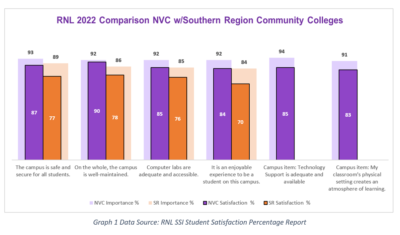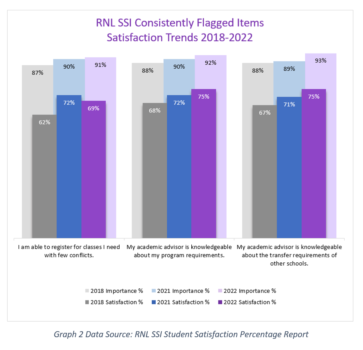In our last Data Bites column, we discussed the Community College Survey of Student Engagement (CCSSE), which NVC administers biannually. The CCSSE represents one measure of our NVC students, but it is not enough to have only one measure. In the years NVC does not administer the CCSSE, we administer the Ruffalo Noel Levitz Student Satisfaction Inventory (RNL SSI), which gives us another dimension by which to measure the current student experience at NVC.
WHY do we administer the RNL SSI?
The RNL SSI measures student satisfaction with a range of items that give us an overview of the student experience in all college areas. The version of the RNL we administer has items that fall on the following scales:
Academic Advising and Counseling Effectiveness
Academic Services
Admissions and Financial Aid Effectiveness
Campus Climate
Campus Support Services
Concern for the Individual
Instructional Effectiveness
Registration Effectiveness
Responsiveness to Diverse Populations
Safety and Security
Service Excellence
Student Centeredness
The survey also allows us to add our own items, which they call “campus items,” so we can get a more specific picture of the student experience at NVC.
HOW does it work?
The RNL SSI asks students to rate both the importance of an item and their satisfaction with it. The difference between those two ratings represents a gap that can help us more effectively interpret the reported satisfaction.
The strategic overview included with the final report shows us starred and flagged items, representing our current strengths and opportunities for improvement. Another report we receive, which we used to create the graphs below, is the Student Satisfaction Percentage report, which reports the percent of students who rated themselves as “satisfied” or “very satisfied.”
Because it is a national survey, the RNL SSI allows us to compare our results to cohorts of other community colleges in the nation or in the southern region. One exception to this is campus items, which we choose ourselves and are not administered to the cohorts.
WHAT have we learned?
For the 2022 administration of the RNL SSI, we were able to identify that six of the items listed as strengths have also been strengths in our previous administrations of the survey. In Graph 1 below, you will see how NVC scored on those six items in 2022, both in terms of importance for students and satisfaction. For the four items that are on the core survey, you will also see how our scores compared with other community colleges in the southern region.
Although the items represented in Graph 1 below are all listed as strengths, any gap between the importance and satisfaction ratings indicates students still see room for improvement.
Graph 1 Data Source: RNL SSI Student Satisfaction Percentage Report
As well as strengths, the survey highlights challenges by flagging items that have a large gap between the student ratings for importance and satisfaction. For consistently flagged items, we can track whether we are making improvement by looking at trends. Graph 2, below, shows three items that have been flagged in all three of our administrations of the RNL SSI. All of these items scored higher in student satisfaction in subsequent surveys than they had on the 2018 survey, showing that we have made progress in all of these areas.
Graph 2 Data Source: RNL SSI Student Satisfaction Percentage Report
WHO does it serve?
Because items on the RNL SSI cover work done in all college areas, it is important that members of a particular college area look at the items that pertain to them. They are the ones who can put the results into context and determine how to address them. In this way, the RNL SSI helps us to serve our students better by better understanding what is important to them in their college experience and how satisfied they are with it.
You can view results from past administrations of the RNL SSI on the IRPE AlamoShare NVC Surveys page to determine if your unit can use results in your area for planning or assessment purposes. To access the AlamoShare page, when prompted enter your username as NVC\username and use your workstation password.
If you are interested in discussing how IRPE can help your unit use data for research, planning, and assessment, reach out to an IRPE team member.
Eliza A. Hernandez, Ph.D.
Director of Institutional Research, Planning, & Effectiveness ehernandez716@alamo.edu
Petra Ortega
IT Data Analyst
portega16@alamo.edu
Deborah Font
Coordinator of Measurement and Evaluation
dfont1@alamo.edu


